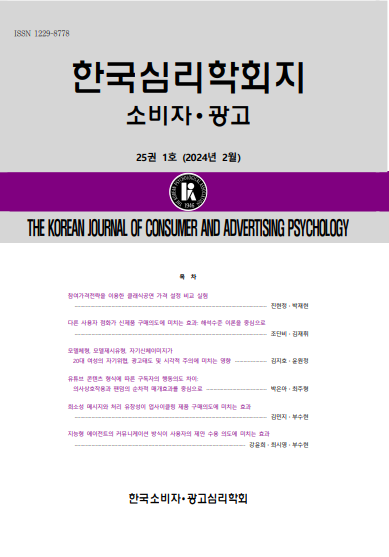open access
메뉴.png)
open access
메뉴 ISSN : 1229-8778
ISSN : 1229-8778
The purpose of this paper was to examine and validate of scale for classification of decision making style. In first study that was exploratory study, 242 undergraduates were asked to answer Korean version of general decision making style(GDMS) scale(Scott & Bruce, 1995) and scale of decision making competency(Nam, 2005). Each scale was consisted of Likert 5 points scale. To examine reliability and validity of Korean GDMS scale, data were analyzed by internal consistency, factor analysis, and correlation analysis. The result showed that internal consistency was high, that 5 factors were extracted and that relationships between factors of decision making style with factors of decision making competency scale were high. Also, construct validity, convergent and discriminant validity as well as reliability were accepted as recognized level. In second study that employed covariance structure model analysis as confirmatory study, 215 participants who include various ages were asked to fill out the shortened Korean version of GDMS that consisted of 20 items. Results showed that both reliability and validity of the shortened Korean version of GDMS were high. Though items were reduced, internal consistency was still high and fitness indexes of confirmatory factor analysis model were high. Finally, in addition to limitations of this study, themes and directions of future research were discussed.
남순현 (2009). 학습자의 의사결정유형에 따른 사회적 쟁점의 분석과정 연구. 한국교원대학교 석사학위 청구논문.
남승규 (1999). 소비자심리학. 서울: 학지사
남승규 (2005a). 소비자 자기조절 모형과 충동구매행동. 한국심리학회: 소비자광고, 6(3), 6-77.
남승규 (2005b). 자기조절모형, 소비자 및 광고. 광고학연구, 6(3): 61-77.
남승규 (2009). 소비자분석. 서울: 학지사.
남승규 (2011). 개인의사결정역량과 조직생산성 및 조직창의성간의 관계. 대전대학교 사회과학논문집, 30(1), 151-173.
이순묵 (2000). 요인분석의 기초. 서울: 교육과학사
Arroba, T. (1977). Styles of decision-making and their use: An empirical study. British Journal of Guidance and Counselling, 5(2), 149-158.
Beckwith, H. (2011). Unthinking. New York: Grand Central Publishing.
Conteh, N. (2009). The hypothesis testing of decision making styles in the decision making process. Journal of Technology Research, 1-17.
Crawford, C. B. (1975). Determining the number of interpretable factors. Psychological Bulletin, 82, 226-237.
Eeidles-Maoz, M. (2006). Personality and decision making styles: The effect of hardiness and spontaneity. Thesis of Roosevelt University.
Friedenberg, L. (1995). Psychological testing: Design, analysis, and use. Allyn & Bacon.
Gambetti, E., Fabbri, M., Bensi, L., & Tonetti, L. (2008). A contribution to the Italian validation of the General Decision Style Inventory. Personality and Individual Differences, 44, 842-852.
Harren, V. A. (1979). A model of career decision making for college students. Journal of Vocational Behavior, 14, 119-133.
Heppner, P. P., Hibel, J., Neal, G. W., Weinstein, C. I., & Rabinowitz, F. E. (1982). Personal problem solving: A descriptive study of individual differences. Journal of Counseling Psychology, 29, 580-590.
Johnson, R. H. (1978). Individual styles of decision making: A theoretical model for counseling. Personnel and Guidance Journal, 56(9), 530-536.
Koeslag, J (1994). Koinophilia. Journal of Theoretical Biology, 167(1), 55-65.
Loo, R. (2000). A psychometric evaluation of the general decision making style inventory. Personality and Individual Differences, 29, 895- 905.
Mitchell, L. & Flin, R. (2007). Shooting decisions by police firearms officers. Journal of Cognitive Engineering and Decision Making, 1(4), 375-390.
Osborne, D. G. (2010). The relationship of goal- directedness, generalized trust, and manager’s decision-making styles. Doctorial Dissertation of Carpella University.
Parker, A. M., Bruine de Burin, W., Fischhoff, B. (2007). Maximizers versus satisficers: Decision- making styles, competence, and outcomes. Judgement and Decision Making, 2(6), 342-350.
Phillips, S. D., Pazienza, N. J., & Ferrin, H. H. (1984). Decision-making styles and problem- solving appraisal. Journal of Counseling Psychology, 31(4), 497-502.
Scott, S. G. & Bruce, R. A. (1995). Decision- making style: The development and assessment of a new measure. Educational and Psychological Measurement, 55(5), 818-831.
Spicer, D. P. & Sadler-Smith, E. (2005). An examination of the General Decision Making Style questionnaire in two UK samples. Journal of Managerial Psychology, 20(2), 137-149.
Thompson, T. S. (2010). The impact of locus of control on decision making styles of mid-level managers. Doctorial Dissertation of Carpella University.
Thunholm, P. (2004). Decision-making styles: Habit, style or both? Personality & Individual Differences, 36(4), 931-944.
Thunholm, P. (2008). Decision-making styles and physiological correlates of negative stress: Is there a relation? Scandinavian Journal of Psychology, 49, 213-219.
Thunholm, P. (2009). Military leaders and followers-Do they have decision styles? Scandinavian Journal of Psychology, 50, 317-324.
Thurstone, L. L. (1947). Multiple Factor Analysis. Chicago: Univ. of Chicago Press.
